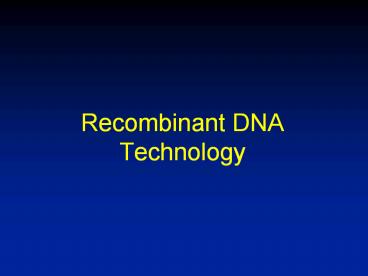Recombinant DNA Technology - PowerPoint PPT Presentation
1 / 40
Title:
Recombinant DNA Technology
Description:
Recombinant DNA Technology Summary Figure after Stryer, Biochemistry Summary Figure after Stryer, Biochemistry Polymorphisms Occur ~ once every 500 nt Usually in ... – PowerPoint PPT presentation
Number of Views:462
Avg rating:3.0/5.0
Title: Recombinant DNA Technology
1
Recombinant DNATechnology
2
Why Do Genetic Engineering?
- 1. Produce desired proteins in vitro for
therapeutic use. - 2. Have rice produce as much starch as a kernel
of corn (in vivo production). - Gene therapy
- Elucidate the function of proteins of interest
3
Steps in Genetic Engineering
- 1. Isolation of gene of interest
- 2. Isolation of plasmid DNA
- 3. Manipulation of DNA sequence
- a. Cutting- Restriction enzymes
- b. Splicing- DNA ligase
- 4. Transformation of bacteria
- 5. Selection of correct bacteria
4
Prokaryote Advantages
- 1. Grow fast
- 2. Manipulation easier
- 3. Eukaryotic technology still somewhat embryonic
5
Prokaryote Disadvantages
- 1. Cant splice out introns
- 2. Introns are needed for good expression
- 3. Size of DNA that can be put into bacteria is
limited - 4. Prokaryotes dont glycosylate proteins
6
Plasmids
- Plasmid- small, circular, extrachromosomal DNA
which replicates independently of host
chromosomal DNA. - Most (experimental) derived from a single
clinical specimen in 1974 - Low copy vs. high copy number
- Incompatible plasmids
7
Isolation of Plasmid DNA
- Lysis by boiling
- Alkaline lysis
- Detergents or organic solvents
8
Isolation of Plasmid DNAOther Steps
- Centrifuge denatured proteins
- Precipitate nucleic acids with salt/EtOH
- Quantify
9
Plasmid MapFigure Harpers Review of
Biochemistry
- Ori
- antibiotic resistance gene(s)
- restriction sites
10
Manipulation of DNA Sequence
11
Restriction enzymes
- Restriction enzyme- an enzyme which cuts specific
DNA sequences, endonuclease - blunt end vs. sticky end
- Cleavage is restricted to specific, 4-6 bp
sequences (foreign bacteria) always palindromic
sequence - More than 800 are now known
12
Restriction Endonucleases
- Type I- multisubunit, endonuclease and methylase
activities, cleave at random up to 1000 bp from
recognition sequence - Type II- cleave DNA within recognition sequence,
require no ATP, most monomers - Type III- multisubunit, endonuclease and
methylase about 25 bp from recognition sequence
13
Select Restriction Endonucleases
14
Generating a Plasmid map
- restriction sites
- sizes when insert included
15
Cloning Vectors
- 1. Plasmids- 5,000 to 400,000 bp
- useful for putting 0.01-10 kb in
- 2. Bacteriophages-virus that infects bacteria
- useful for putting 10-20 kb in
- 3. Cosmids- artificially generated
- useful for putting 20-50 kb in
- 4. YACs- yeast artificial chromosomes
- useful for putting 500 kb
- 5. Other, newer exist
16
Other Important Vectors
- 1. Baculovirus- infects insect (Sf9, e.g.) cells
- 2. For plants, wound and infect with engineered
Agrobacterium tumefaciens
17
Transformation of Bacteria
18
CaCl2 Transformation
- Cells and DNA incubated together in CaCl2 at 0oC,
then heat shock at 42oC - How this makes cells competent to take up DNA
is not known - Only a small percent of cells take up DNA- must
select for them
19
Newer Methods of Transformation
- Lipofectin and similar molecules
- Electroporation
- Microinjection
20
Selection of Correct Bacteria
21
Antibiotic Resistance Genes are a Part of Many
(Constructed) Plasmids
- Follow with replicate plating of transformants on
Amp and Tet
22
Blue-White ScreeningPromega Corp Madison, WI
- pGEM-3Z, e.g.
- Ampr
- lacZ
- polycloning site in lacZ gene
- T7 promoter one side, SP6 other
23
DNA Sequencing
- Sangers first
- Radiolabeled vs. fluorescent tag
24
Isolation of Gene of Interest
25
Isolation of Gene of Interest Use of Antibodies
- Ab ppt protein
- Protein being synthesized on mRNA
- Generate cDNA from mRNA
- reverse transcriptase
- DNA polymerase
- Must have protein in pure form
26
Isolation of Gene of Interest Genomic Library
Screening
- Isolation of total genome
- Fragments and their sizes
- How many fragments to get entire genome can be
calculated - Fragments put into a vector
- Vectors are hybridized with a probe
- Dont need protein, but must know at least part
of sequence
27
HybridizationFig. 9-9 Lehninger POB 4th Ed.
- Bacterial colonies containing plasmid library are
grown up - Paper is used to pick up cells of each colony
- Paper is incubated in radiolabeled probe and
washed - Autorad of paper Ids colonies containing gene of
interest
28
Isolation of Gene of InterestPolymerase Chain
Reaction (PCR)
- Taq polymerase
- Equipment- thermocycler
- Procedure- Taq template primer
- Dont need protein, but must know at least part
of sequence - The real power here is ability to amplify DNA
29
SummaryFigure Stryer, Biochemistry
30
SummaryFigure after Stryer, Biochemistry
31
SummaryFigure after Stryer, Biochemistry
32
SummaryFigure after Stryer, Biochemistry
33
SummaryFigure after Stryer, Biochemistry
34
SummaryFigure after Stryer, Biochemistry
35
SummaryFigure after Stryer, Biochemistry
36
Polymorphisms
- Occur once every 500 nt
- Usually in noncoding region
- If in coding region, leads to disease
- Used to ID victims and suspects and parents
37
RFLP
- Restriction Fragment Length Polymorphism,
pronounced riflip - Same pattern which exists in gt1 of the
population - Inherited
- Thousands known
38
Box 9-1
39
SNP
- Single Nucleotide Polymorphism, pronounced snip
- Major focus, leading to individualized medicine
40
DNA MicroarraysFig. 9-22 Lehninger POB 4th Ed.
41
Mammalian Expression Promoters
Promoter Source Advantage
CMV Human cytomgalovirus immediate-early gene Proven high-level expression in a variety of mammalian cell lines
EF-1a Human elongation factor la subunit gene Strong constitutive expression in mammalian cells use in cell lines that down-regulate viral promoters
UbC Human ubiquitin C gene Efficient expression across a broad range of tissues and mammalian cell types
Sv40 Simian virus 40 Constitutive expression with higher expression levels in cells that express the large T antigen































